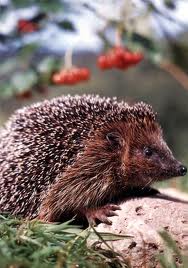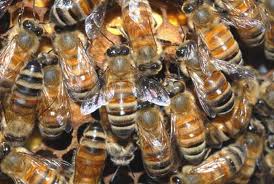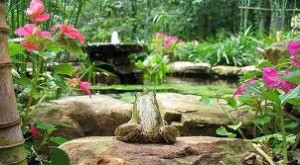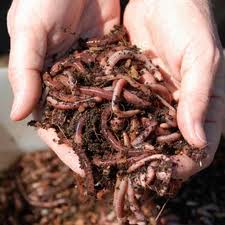





Pests are an essential part of the ecology and a resource for others. Pests are only pests when they eat our crops or ornamentals, otherwise we would see them as wildlife, recyclers and pollinators. For instance, woodworm in a dead log is a recycles, but in the tree, post or table it becomes a pest. Some pests are also friends; thrips and capsid bugs damage some plants but eat tremendous numbers of spider mites.
Plants in nature come to a balance with their pests. It is only when we grow monocultures or eliminate the natural controls that they run rampant. However, pests seldom do much harm to healthy plants that are growing well – most things we grow are remarkably trouble free, after all. The pests we have to take note of are few and mostly concern a few susceptible vegetables and fruits. It is important to note, that that we are looking to control, not eliminate, when we are faced with outbreaks of garden pests. We need a few pests to survive or there will be nothing to keep the predators alive, and without them any new pest would soon escalate into a problem. After all, if there were no snails there would probably be no song birds, and even snails are useful since they consume diseased and wilted material.
 As with all natural food webs, some creatures are predators and some are prey. In the garden, the predators are largely beneficial as they eat pests, controlling their numbers and preventing their spread. The predators and parasites in a stable ecosystem need pests in order to live. Left to themselves they control pest numbers very effectively in a complicated web where they prey not only on the pests but also on each other. This is particularly true of the larger predators, such as hedgehogs and birds, which will eat almost anything, regardless of whether it is a friend or foe to us.
As with all natural food webs, some creatures are predators and some are prey. In the garden, the predators are largely beneficial as they eat pests, controlling their numbers and preventing their spread. The predators and parasites in a stable ecosystem need pests in order to live. Left to themselves they control pest numbers very effectively in a complicated web where they prey not only on the pests but also on each other. This is particularly true of the larger predators, such as hedgehogs and birds, which will eat almost anything, regardless of whether it is a friend or foe to us.
Ladybirds are well-known predators, but almost all beetles account for slugs and other small pests and their eggs. Spiders are predatory, every one, and can number many millions in a large, healthy garden. Hoverflies, lacewings, anthocorid bugs and wasps all help control spider mites, aphids, caterpillars and other pests. Similarly, there are numerous parasites such as chalcids, ichneumon flies and other minute wasps that live on and even in their hosts.
The problem with these predators is that they breed more slowly than the pests. This is usually of no consequence, as other factors, such as lack of food, also restrict the pests. But if you use a pesticide and accidentally kill some of the predators along with the pests, then the latter resurge out of control. It can take many years to rebuild a complex, self-regulating system if it is badly disrupted. Thus all pesticides are better avoided, even the less toxic, organically approved ones. By growing a wide variety of plants — especially sacrificial plants that can have pests on them to little detriment such as honeysuckles, sweet cherries, nettles and lupins — you can maintain a background level of predators that controls the pests on other plants throughout the rest of the garden. Ground-cover plants, even strips of rough grass, are important for the walking predators, such as beetles. You can provide flying insect predators with nectar and pollen to attract and keep them working in your garden, and further down this page on I suggest plants for this purpose (featured in bold text).
Bees are the best-known pollinator but hoverflies, flies, butterflies, beetles and wasps all transfer pollen. Bumble bees are more important to early-flowering plants than honey bees (which fly only in warmer weather). They can be bought in cardboard huts to hang in greenhouses. The main requirement for encouraging more pollinators is more flowers, flowering through the longest season possible.
 This is the largest of the subsystems; the vast majority of small creatures are recycling material discarded by larger forms. Of course, they may fancy a bit of meat with their diet and the apparently innocuous woodlice have been observed killing young caterpillars. The larger creatures often recycle without consuming, as they forage and disturb the litter or peck apart a rotten log in search of grubs. Pollinators are not only pollinating the flowers, but recycling pollen and nectar as more pollinators; these too live and die, adding their droppings and bodies to soil fertility. This is not insignficant. A colony of honey bees has from 30,000 to 100,000 bees in it at any one time and most of these live only six to eight weeks in summer. Thus a colony loses up to 10,000 bees a week to natural death and predators.
This is the largest of the subsystems; the vast majority of small creatures are recycling material discarded by larger forms. Of course, they may fancy a bit of meat with their diet and the apparently innocuous woodlice have been observed killing young caterpillars. The larger creatures often recycle without consuming, as they forage and disturb the litter or peck apart a rotten log in search of grubs. Pollinators are not only pollinating the flowers, but recycling pollen and nectar as more pollinators; these too live and die, adding their droppings and bodies to soil fertility. This is not insignficant. A colony of honey bees has from 30,000 to 100,000 bees in it at any one time and most of these live only six to eight weeks in summer. Thus a colony loses up to 10,000 bees a week to natural death and predators.
Insect bodies are rich in chitin, which makes up much of their tough skin, and is thought to be beneficial to soil and plant health.
In a sense we are all recyclers. Plants build up their materials from air, light, water and the nutrients released from organic matter as it decomposes. All other life breaks down plants, other creatures and their by-products. The faster the turnover and the more forms of life we encourage the more our garden will support. Most of nature’s recyclers live on or in the soil surface, where most things fall at the end of their life. Without them the world would long ago have filled up with smelly little corpses. Recyclers spend their lives converting dead and diseased material into plant food. These processes go on most rapidly in aerated, warm, moist conditions as found under groundcover plants, a layer of leaves or a mulch. By duplicating these conditions we aid recyclers and if we supply them with organic material they will convert it into fertility.
However, remember that the predators are just as keen to eat the recyclers as the pests, so we need to provide refuges as well. Small piles of rotting logs, rocks, bricks or even bottles are ideal and can be hidden under hedges and evergreens. Some recyclers, such as snails, which are often regarded as pests, will also congregate in these refuges, so we can use them as collection points where they can be caught and dispatched.
Butterflies are often pests in disguise, but are more usually useful pollinators; their beauty alone is reason enough to encourage them. Many flowers can provide them with food, as butterflies have long tongues, and of course some rely on specific plants for their caterpillar stage. buddleia , Sedum spectabile, golden rod (Solidago), valerian and lavender all attract butterflies. So too do: Dianthus, Hesperis, honeysuckle, hyssop, lilac, Lychnis, Lythrum, Myosotis, Origanum and Viola. Many other flowers are visited especially those with yellow, orange or red blooms. Night-scented flowers are appealing to moths which can detect their fragrance from further afield in the still, moist air of evening.
Bees – Many species are under threat because of the widespread loss of native wildflowers. Each of us can help by putting a few bee plants in, and it is in our interest to do so. In the short term we benefit from the pollination of fruit; in the long term we may save ourselves. If bees die out whole families of plants may disappear. Bumble bees and leaf-cutter bees are even more valuable than honey bees (although they give no honey) as they fly in colder conditions and pollinate earlier in the year.
All bees need continuous supplies of pollen and nectar so many different flowers should be grown to spread the season. Bumble bees especially need early spring flowers such as Aubrieta, Berberis, bluebells, dandelions, flowering currants, wallflowers and white dead nettle. From early summer they’ll go for brambles and their hybrids, buddleia , clover, comfrey, Cotoneaster, Fuchsia, globe artichoke and cardoon, golden rod (Solidago), jasmine, knapweed, lavender, mallow, Michaelmas daisy, raspberry, rhododendron, thistle and vetch.
Hoverflies are the best aphid eaters we can encourage. Their larvae eat many more in a day than ladybird larvae — up to an aphid a minute! The adults are attracted to yellow flowers, such as broom (which provides their favourite aphid), yarrow and knapweed. But the best plant to bring adult hoverflies into your garden is the low-growing, self-sowing annual Limnanthes douglasii. Commonly known as the poached egg flower, it should be grown anywhere you can fit it in, filling the garden with hoverflies and bees. Buckwheat and Convolvulus tricolor are excellent for supplying nectar later in the season. Most flowers will benefit hoverflies, including: Alyssum, Arabis, Aubrieta, cornflower, Cosmos, Eschscholzia, Geranium (but not Pelargonium), golden rod, grape hyacinth, heliotrope, honesty, Iberis, all marigolds, Michaelmas daisy, Nemophila, Nicotiana, Petunia, Phlox, all poppies, Rudbeckia, Sedum spectabile, Shasta daisy, stocks, sunflower, sweet rocket, sweet William and Wivelsfield, tansy, all the mints and wallflowers. Letting celery and carrots go to seed will also encourage hoverflies and many other beneficial insects.
Ladybird and lacewing adults may take nectar or pollen from the same plants as hoverflies but they also like Allium, Anthemis (dill), fennel and yarrow. In one experiment, lacewings fed only on aphids did not lay eggs. The best encouragement for any predator is plenty of tempting food. Grow plants that are regularly laden with aphids — patches of nettle, honeysuckle, lupins, sweet cherries — and you will soon be maintaining a healthy background level of predators and parasites. The overwintering adults of ladybirds and lacewings are fond of hibernating in conifers, evergreen hedges and dense culinary herbs. Nest boxes made from hollow stems are particularly useful for them, and should be secreted in dry places.
Wasps are good friends for most of the year, eating pests in the spring and summer, but when autumn comes they eat all the fruit! Dead rotting wood will provide wasps with the raw material for their paper-like nests. All the nectar-producers recommended for hoverflies will encourage wasps to some extent, but more importantly will benefit their relatives the predatory wasps which parasitise caterpillars, beetles, aphids and spiders.
Spiders are all friends and are very sensitive to pesticides. The best way to encourage them is to provide the right type of habitat. Under cover, I supply strings to start their webs in the places that are convenient, as well as water and bundles of hollow stems for them to nest in.
Beetles are a very large group; most, such as ladybirds, are friends, but there are exceptions such as the wood-boring varieties. Beetles are good pollinators in cold, wet conditions when other creatures can’t fly, though some, such as pollen beetles, can steal too much. Thick groundcover stops useful ground-dwelling beetles from being spotted by bigger predators: dense foliaged plants that collect dew are thus doubly useful. Plants with hiding places between their leaves, under rough bark, in congested twiggy areas and even in deadwood will help hide or hibernate beetles and other creatures.
 Frogs, toads and newts eat many pests, but they need water and wet places to live in. They will be keener to patrol the garden if there is good groundcover, preferably moist underneath. Provide a lush, moist overgrown corner in the greenhouse and you will have frogs and toads living and dining there. Newts are just as useful and more interesting to watch, especially their dance at mating time. I made the end of my polytunnel abut the pond and a low log wall provides access, so all these friends can come into the warm and eat pests while they are visiting. Generally, newts and frogs will not breed in the same small pond, so if you have the space consider having two small ponds instead of one larger one.
Frogs, toads and newts eat many pests, but they need water and wet places to live in. They will be keener to patrol the garden if there is good groundcover, preferably moist underneath. Provide a lush, moist overgrown corner in the greenhouse and you will have frogs and toads living and dining there. Newts are just as useful and more interesting to watch, especially their dance at mating time. I made the end of my polytunnel abut the pond and a low log wall provides access, so all these friends can come into the warm and eat pests while they are visiting. Generally, newts and frogs will not breed in the same small pond, so if you have the space consider having two small ponds instead of one larger one.
Birds – Gardeners often wish to get rid of birds, but on the whole, they are definitely beneficial. The main exceptions are pigeons, magpies and seagulls. Most other birds are hungry friends always looking for snacks -most of which are pests – and they control more pests than they spoil crops. Individual crops may need protecting, but in the end we all benefit from more birds. We can attract birds by providing the right habitat and a reliable food supply, but water is essential. Like us, they appreciate a bath – somewhere the cat can’t get at them.
If you want to attract birds, grow fruit of any sort. As is all too soon apparent, birds much prefer cultivated fruit to the wild fare nature provides. Redcurrants and cherries disappear fastest, but hardly any fruit makes it through winter. Berries of any sort are equally appreciated, though yellow ones apparently confuse the birds for a while before disappearing rapidly. Often they are just after the succulence, so you can reduce potential damage by providing water for them to drink. The more fruit you grow the less damage your resident population can do, so plant sacrificial crops of berrying trees and shrubs and enjoy all the wildlife that this brings. Seeding plants – especially sunflowers and wheat – will also attract and feed them, and some heads can be saved for the winter.
All dense-growing hedges, evergreens and climbers favour birds by providing loads of useful nooks and crannies for nest building and shelter. Suitable nesting sites in the wild are increasingly rare, so provide nest boxes in your garden. Encourage the most useful birds, such as blue tits, great tits, tree sparrows and other small insectivorous birds. The ideal nest site for most small insectivorous birds is an old woodpecker’s hole – they always use them in preference, but few are available. The inside shape is more important than the outside appearance and a stark rectangular box is not a good substitute – a deep, rounded bowl is required and is best made with a papier mache insert. Robins, flycatchers and wagtails prefer their box to have a bigger, wider, more open front. Boxes ought to resemble natural holes and should be fixed to trees, safe from cats and other predators. Put them where you can watch from a window, except for the robins, who like the boxes to be well hidden away in shrubs or hedges. Many of the other birds, such as blackbirds and thrushes, find ample nest sites amid dense evergreens or thick hedges. Bend suitable branches down out of sight and tie them together to form a nesting platform, or prune them back hard to form clusters of splayed shoots suitable for lodging a nest.
Swallows and house martins bind their nests together with mud – of which there is now a shortage, as garden ponds rarely have muddy edges. There are also fewer piles of strawy dung or livestock leaving hair on hedges, which deprives house martins of the other material they need. If they make them out of mud alone, the nests have nothing to strengthen them, so they fall off when the mud bakes and shrinks. So hang hair trimmings and put out bowls of mud by the pool edge for these useful insect eaters.
 Worms – Remember, if you want to hear songbirds, you need worms! Worms are probably the most important creatures in the garden. They can excrete thirty or more tons of ‘casts’ per acre per year — the very best soil texturiser and fertiliser. Worm casts are water stable (so soil containing plenty of them does not get too muddy) and have a granular texture that promotes plant root growth. Worm burrows also act as aeration and drainage channels, and when abandoned are followed down by plant roots for their nutrient-rich lining. The digestive process of worms reduces mineral particles in size, making them more accessible to micro-organisms. Worms are encouraged by keeping the soil moist and covered with a mulch.
Worms – Remember, if you want to hear songbirds, you need worms! Worms are probably the most important creatures in the garden. They can excrete thirty or more tons of ‘casts’ per acre per year — the very best soil texturiser and fertiliser. Worm casts are water stable (so soil containing plenty of them does not get too muddy) and have a granular texture that promotes plant root growth. Worm burrows also act as aeration and drainage channels, and when abandoned are followed down by plant roots for their nutrient-rich lining. The digestive process of worms reduces mineral particles in size, making them more accessible to micro-organisms. Worms are encouraged by keeping the soil moist and covered with a mulch.
I feed all bare soil and most mulched areas with a handful of grass clippings every month or so as they need ‘greens’ as well as organic material, such as compost or well rotted manure. They will multiply if fed on ground seaweed, blood, fish and bone meal and hoof and horn meal. It is better not to rotary-cultivate and to dig only by hand, and minimally, as both these processes kill worms. In acid soils, add lime every four years or so unless you grow lime-hating plants. Adding lime for the worms is most important for the vegetable bed and for most hard-wearing grass swards. Lime keeps the soil sweet and feeds the worms, which then ensure the efficient drainage, aeration and recycling of all the material in the bed or under the sward.
Hedgehogs are well-known friends, but do not thrive on the traditional milk and bread — dog or cat food is a better treat! Plant dense-growing shrubs with dry centres for them to hibernate in. Hedgehog boxes can be put underneath shrubs or hedges. Make them waterproof, at least a foot cubed, with a fist-sized entrance hole, and stuff them full of dry leaves, hay or shredded newspaper.
Bats eat tremendous numbers of flying pests. They are best encouraged by providing both roosting and hibernating sites. The former are flat, wooden boxes, open underneath, which need to be attached high up on warm walls. The latter are harder to create. Some trees, such as limes, with large crops of aphids, will continually shower them off in the slightest breeze and these attract bats.
The Benefits Of Community Gardens
The Benefits of Using Shade Sails in Your Garden
The Benefits of Using Herb Garden Kits
What are the Benefits of Ergonomic Garden Tools?
Grow an Organic Vegetable Garden: Reap the Benefits
The Benefits of a Cantilever Parasol in Your Garden
Welcoming Wildlife In The Garden: How To Create A Wildlife Garden
Copyright © www.100flowers.win Botanic Garden All Rights Reserved